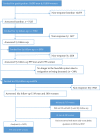Mediating Factors for the Relationship between Stress and Work Ability over Time in Young Adults
- PMID: 32272748
- PMCID: PMC7177359
- DOI: 10.3390/ijerph17072530
Mediating Factors for the Relationship between Stress and Work Ability over Time in Young Adults
Abstract
Stress can affect work ability. The aim of this study was to identify how this pathway is mediated over time in young adults. Participants of the Work Ability in Young Adults cohort were selected. A theoretical framework was built, which lead to a statistical model. Selected dimensions of mediators were recovery, work demands affecting private life, feelings of control over private life, and physical activity in leisure time. A quadruple serial mediation model was built with four mediators. The total effect of stress on work ability was -0.3955, 95% CI [-0.4764, -0.3146]. The total indirect effect amounted to 81% with an effect of -0.3182, 95% CI [-0.3750, -0.2642]. The relationship between stress and Work Ability Score five years later in young adults was mediated by stress five years later, work demands affecting private life, feelings of control over private life and feeling well-rested upon waking. These results indicate that work demands affecting private life and feelings of control over private life are important mediators of the relationship between stress and work ability in young adults. A well-balanced relationship between work and private life can counteract the influence of stress on work ability in this age group.
Keywords: Mediation; sustainable employability; work ability score; work-private life balance.
Conflict of interest statement
All authors declare having no conflict of interest. Financial support was provided by AFA insurance. Data availability: Data cannot be shared publicly as information about health and personal factors are regarded as sensitive information, and when sharing such data there has to be an approval from a Swedish Ethical committee (according to Swedish law) even if data is anonymized. Data is available with an approval from an ethical review board. For data requests, contact: School of Public Health and Community Medicine, Gothenburg University, Box 414, 405 30, Gothenburg, Sweden. The name of the data set is “WAYA” (Work Ability Young Adults).
Figures










Similar articles
-
Changes in work situation and work ability in young female and male workers. A prospective cohort study.BMC Public Health. 2012 Aug 24;12:694. doi: 10.1186/1471-2458-12-694. BMC Public Health. 2012. PMID: 22920936 Free PMC article.
-
Medical students' perceptions of stress due to academic studies and its interrelationships with other domains of life: a qualitative study.Med Educ Online. 2019 Dec;24(1):1603526. doi: 10.1080/10872981.2019.1603526. Med Educ Online. 2019. PMID: 31007152 Free PMC article.
-
Effects of a leisure programme on quality of life and stress of individuals with ASD.J Intellect Disabil Res. 2010 Jul;54(7):611-9. doi: 10.1111/j.1365-2788.2010.01289.x. Epub 2010 May 25. J Intellect Disabil Res. 2010. PMID: 20500784 Clinical Trial.
-
High-demand jobs: age-related diversity in work ability?Appl Ergon. 2006 Jul;37(4):429-40. doi: 10.1016/j.apergo.2006.04.007. Epub 2006 Jun 9. Appl Ergon. 2006. PMID: 16764815 Review.
-
The influences of recovery on low back pain development: A theoretical model.Int J Occup Med Environ Health. 2015;28(2):253-62. doi: 10.13075/ijomeh.1896.00269. Int J Occup Med Environ Health. 2015. PMID: 26182921 Review.
Cited by
-
The Effect of Emotional Intelligence and Academic Social Networking Sites on Academic Performance During the COVID-19 Pandemic.Psychol Res Behav Manag. 2021 Jun 29;14:905-920. doi: 10.2147/PRBM.S316664. eCollection 2021. Psychol Res Behav Manag. 2021. PMID: 34234587 Free PMC article.
-
Social determinants of financial stress and association with psychological distress among young adults 18-26 years in the United States.Front Public Health. 2025 Jan 7;12:1485513. doi: 10.3389/fpubh.2024.1485513. eCollection 2024. Front Public Health. 2025. PMID: 39845680 Free PMC article.
-
Mediating effect of behavioural intention on podcast acceptance.Educ Inf Technol (Dordr). 2021;26(3):2767-2794. doi: 10.1007/s10639-020-10385-z. Epub 2020 Nov 13. Educ Inf Technol (Dordr). 2021. PMID: 33223925 Free PMC article.
-
"We are dragged along like dogs and take damage …" - Adolescents' experiences affecting their mental health during vocational training in a health or social care profession - an interpretative phenomenological analysis.BMC Public Health. 2025 Apr 28;25(1):1574. doi: 10.1186/s12889-025-22852-8. BMC Public Health. 2025. PMID: 40296040 Free PMC article.
-
How Emotional Intelligence Influences Cognitive Outcomes Among University Students: The Mediating Role of Relational Engagement During the Covid-19 Pandemic.Front Psychol. 2021 Oct 25;12:711439. doi: 10.3389/fpsyg.2021.711439. eCollection 2021. Front Psychol. 2021. PMID: 34759861 Free PMC article.
References
-
- Roelen C.A., van Rhenen W., Groothoff J.W., van der Klink J.J., Twisk J.W., Heymans M.W. Work ability as prognostic risk marker of disability pension: Single-item work ability score versus multi-item work ability index. Scand. J. Work Environ. Health. 2014;40:428–431. doi: 10.5271/sjweh.3428. - DOI - PubMed
Publication types
MeSH terms
LinkOut - more resources
Full Text Sources
Medical

